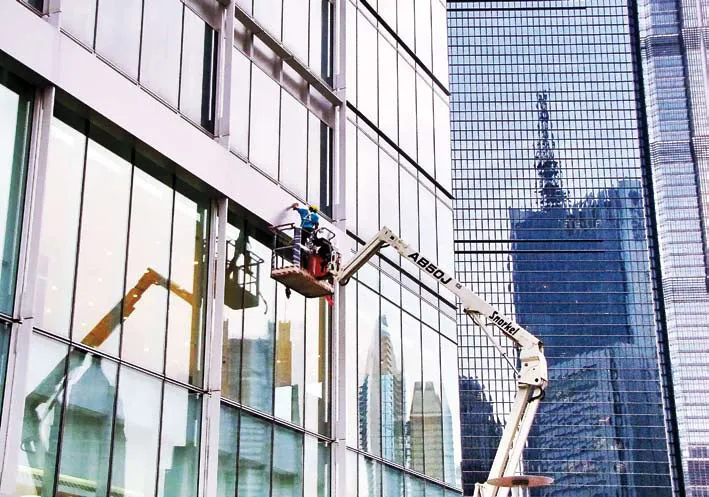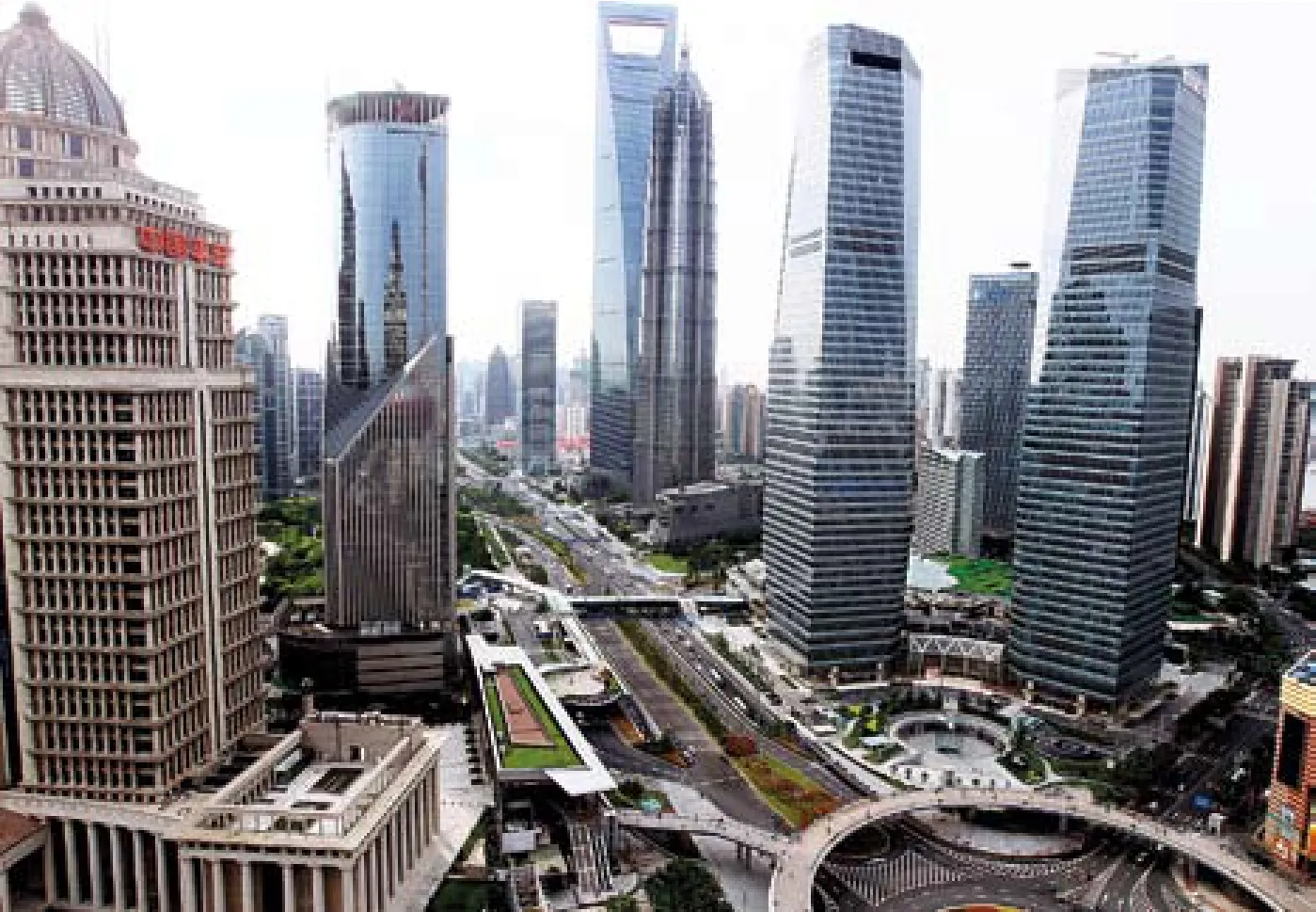GLASS SWORD OF DAMOCLE
By YUAN YUAN
GLASS SWORD OF DAMOCLE
By YUAN YUAN

CFP
A string of accidents draws attention to the safety of the gleaming glass-walled skyscrapers, now common in China’s major cities
On July 8, as 19-year-old Zhu Yiyi was walking past a 23-story building in Hangzhou, east China’s Zhejiang Province, shards of glass falling from a shattered window on the 21st foor of the building hit her left leg.
The glass severed the arteries in her left thigh and left a 20-cm laceration on the left lower limb. The injuries left Zhu with no choice but to have her leg amputated at the knee.
Zhu’s is not the only accident caused by glass curtain walls in recent months. In May, 50 vehicles were damaged by broken glass falling from the 46th floor of a skyscraper in Lujiazui Financial District in Shanghai. Also in Shanghai, on August 9, 30 panes of glass rained down upon a residential area in the city’s central business district, injuring a passer-by.
On August 20, in another city of Zhejiang Province, Yiwu, the 20-meter-high glass ceiling of a garment market came crashing down, injuring several children.
“Several kids were crying, and there were blood and glass everywhere. A boy of about 10 was lying there, with flesh cut from his lower legs. I could even see the bones,” said a shopkeeper in the market.
Problems
High temperatures were blamed for the cracking of the glass in those cases. The glass used in the exterior walls of skyscrapers is usually armored glass, which contains nickel sulfide particles and other impurities. The glass is subject to sharp temperature differences as building’s air-conditioned interiors are much cooler than the outside air, especially on hot summer days. This difference in temperature can cause armored glass to burst, though experts say only poor quality and badly maintained glass is prone to bursting.
“The fundamental cause of the accidents is the government’s failure to establish effective safety standards for glass curtain walls,” said Lu Jinlong, Assistant Engineer in Chief of the Shanghai Research Institute of Building Sciences.
The glass curtain wall was introduced into architecture in 1926 in Germany, and swept over the Western world in the 1970s. The first building with glass-clad walls in China appeared in 1985 in Shanghai.
The style soon became popular for its modern, airy look and currently an upsurge in the construction of glass curtain walls is underway across China.
Statistics from the China Architectural and Industrial Glass Association show that China constructs 70 million square meters of glass curtain walls each year, 75 percent of the world’s total. Buildings in China have more than 200 million square meters of glass curtain walls, 85 percent of the world’s total.
“China’s first technical code for glass curtain walls was not launched until 1996. But 20 percent of Shanghai’s highrises with glass curtain walls were built earlier than that. The design and the quality inspection of glass curtain walls on these buildings were mostly substandard. Many glass curtain walls have a high risk of cracking and falling and they are practically ticking time bombs. Those constructed more than 15 years ago pose the highest risk,” Lu said.
Shanghai has about 3,000 buildings with glass curtain walls, the most in China. About 900 of them are more than 15 years old, according to Lu.
“The safety of glass curtain walls is directly related to the engineering design of the building, the material quality of the glass and the skill used in its installation and maintenance. Any negligence in the details might lead to an accident,” said Rao Rong, a professor at Tsinghua University’s School of Architecture.“The glass curtain wall was technically mature when it was introduced to China in the 1980s, but many human errors such as lack of maintenance are to blame for accidents causing injury or damage,” he said.
Xiang Hua, a sales manager at the Shanghai Kesheng Curtain Wall Engineering Co., said that many buildings used low-quality glass to reduce cost, which also increased the danger.
“Based on the current technical code for glass curtain wall engineering, which was put into force in 2003, safety glass and dualpane insulating glass are compulsory in tall buildings. However, the cost of safety glass is much lower than double-insulating glass. A square meter of safety glass costs 80 to 100 yuan ($12.50 to $15.70), but the same size of double-insulating glass at least doubles the price,” Xiang said.
According to Xiang, for the sake of safety, glass curtain walls need to be checked every fve years, and those over 15 years need a thorough safety check.
“But repair and maintenance are not cheap,” said Yu Hui, a professor at the School of Architecture and Fine Arts of Dalian University of Technology. “For some glass panes high up in the sky, checking each square meter costs more than $100.”
Zhou Hongjun, a professor at East China University of Political Science and Law, believes the construction of many buildings with glass curtain walls takes only the attractive exterior into account. “It overlooks the fact that cities in China have dense populations,” he said.
According to Zhou, glass curtain walls are more than just a safety hazard, they cause light pollution and lead to excessive energy consumption because of the easy passage of heat.
The energy consumption of buildings with glass curtain walls is reportedly four times greater than that of ordinary buildings. People inside glass curtain walls often feel cold in winter and hot in summer, leading to increased use of air conditioners.
Glass curtain walls also act as huge mirrors that refect sunshine and light. Medical researches suggest that excessive light exposure or the improper spectral composition of light may cause headaches, eye problems, work fatigue, stress, decreased sexual function and increased anxiety. In addition, glass walls can refect traffc signals and produce illusions that can cause traffc accidents.

CHEN FEI

YUE YUEWEI
“Energy conservation and emissions reduction have become a widespread concern. It’s time to limit the large-scale installation of glass curtain walls in new public buildings in China,” said Liu Junyao, Deputy Director of the Shenzhen Institute of Building Research.
Ways out
“Glass curtain walls, as external structures, have an average design life of 25 years. The service life of supporting parts, such as bolts and adhesives, is generally 10 to 15 years. They can become loose, rusty and unreliable,” said Zhao Xi’an, a researcher with the China Academy of Building Research.“Some glass curtain walls overseas still work well after 50 or 60 years, thanks to timely checkups and maintenance. But there is no maintenance industry for glass curtain walls in China.”
Following repeated accidents with casualties caused by glass curtain walls, some Chinese cities have worked out their own regulations on the issue.
The Construction and Administration Bureau of Xiamen in southeastern Fujian Province issued a notice on September 15, requiring all skyscraper owners to check glass curtain walls and submit a report before December 15 of this year.
According to a survey, there are over 2,000 glass curtain walls in Xiamen, of which more than 200 are more than 10 years old. The glass curtain walls of the city’s frst skyscrapers have been installed for more than 20 years. But the warranty period of the glue used to bond the glass curtain walls and metal structures is only 10 years.
On October 22, Shanghai issued a new draft regulation on glass curtain wall construction and management aimed at allaying safety concerns.
The draft regulation says glass curtain walls will be banned in newly-built apartments, hospitals, schools, kindergartens and rest homes. Restrictions will also be placed on the construction of such walls in scenic sites and places of historic and cultural signifcance. It also mandates safety inspections every four years.
Earlier, Shanghai authorities announced on July 29 that the city was going to conduct a thorough safety inspection of all the buildings with glass curtain walls and the work would be completed by the end of March 2012. The authorities also set the penalties from 10,000 yuan ($1,566) to 100,000 yuan ($15,660) to deter owners from skipping inspections.
“It is a bit late to set rigid restrictions, but not too late,” said Lu. “We must be frm in the implementation of the new regulations.”
Experts also called for more preventive measures, such as establishing or increasing green areas and other buffer zones around tall buildings, and requiring ceilings or awnings to be made of dual-pane glass or other stronger materials to protect pedestrians.
“In a bid to prevent similar ‘glass rain’accidents, the government also needs to speed up the lawmaking process to regulate companies that work on glass curtain walls,”Lu said. “An insurance system is highly recommended to help solve some of the current problems.”

